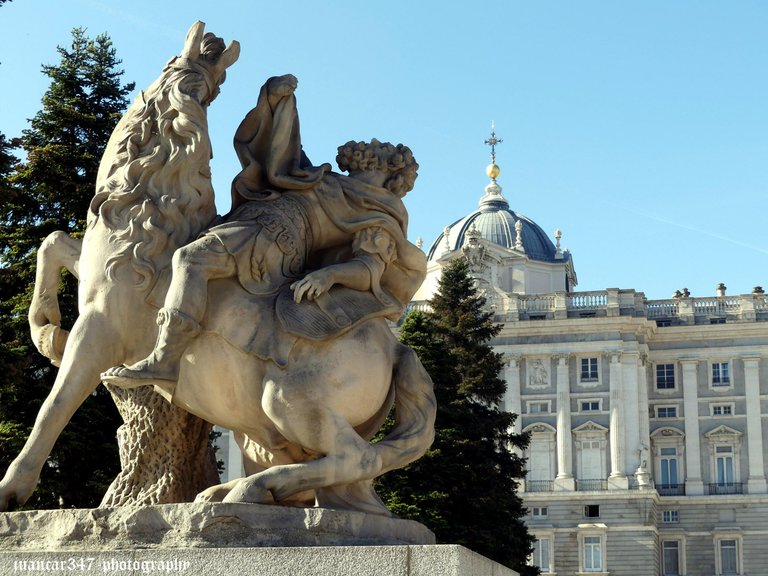
Possibly, they are not as spectacular as the famous Gardens of Aranjuez -immortalized by that great Spanish musician, who was Master Rodrigo- nor as those of the Granja of San Ildefonso or those of the Riofrio Palace, both located in Segovia, but it is an indisputable fact that these memorable gardens, bearing the surname of the great Italian architect, Sabatini, to whom Madrid owes many monumental works, are also an invitation to the pleasure of the senses.

Like the Garden of Earthly Delights - that famous and controversial painting by Hieronymus Bosch, El Bosco, for which kings like Felipe II felt a true obsession and today occupies one of the most prominent places in the great pictorial collection of the Prado Museum - they also enjoy of metaphorical 'angels and demons' -irreconcilable combatants on the battlefields of symbolism- that awaken the senses, animating, in the viewer's mind, the old myths, whose influence belongs to the realm of the infinite possibilities of the Psyche.

In such a way that in them we find, in the surrounding hedges, which form intricate passages, one of the most universal metaphysical symbols that exist: the labyrinth.

In fact, if we turn to that difficult situation, which is to always try to maintain objectivity, we could say that Architecture, in a generic sense, is one of the largest consumers of labyrinths that exist: reaching the heart of the house implies going through, as in these, numerous rooms, each of which possesses its own characteristics and jealous guardian of its subjective secrets.

The 'magic of water', vital in any self-respecting garden - let's not forget, giving a brief review of some of the Western architectural achievements, such as medieval monasteries, details as important as the well that occupied the central place of the gardens of the cloisters and that at each of its cardinal points represented the four rivers of Paradise - is also present, not only in the numerous fountains, but also in that imitation of the sea, symbolically and metaphorically speaking, which are the ponds.

Water, in which not only the moon and the stars are reflected on clear nights and which lead to speculation with that hieros-gamos or sacred marriage with which sometimes similar themes are accompanied in the background, such as design and poetry , but also in the accompaniment of that glimpse of immortality, which always accompanies the statues of those who preceded us, who contemplate us on their polished surface, giving the impression that they continue to observe us from the border of that intuited and at the same time feared More There and that introduce us to another of the great mysteries of metaphysics: the speculative universe of reflection.

The reflection, symbolically speaking -and in this sense, let us remember that Architecture is also pure symbolism- is a glimpse of ourselves: the stalking of our 'I', which contemplates us, in the image and likeness, from that other parallel universe , where sleep and wakefulness are intimately connected - in the same way, it could be said, that a house and its tenant - through the umbilical cord of the archetype and that reminds us, as the French surrealist poet Paul Eluard affirmed, that there are other worlds, but they are in this one.

Now, abandoning from here on the fascinating world of the senses and symbolic speculation, to enter the world of classification and historicism - details that, in my opinion, characterize a world devoid of poetic perspective - it is It is legal to state that these gardens are of modern execution and if they bear the name of the brilliant Italian architect in their name, as we mentioned at the beginning, it is simply because they are located next to the north façade of the Royal Palace built by him, in the land that was formerly occupied by the stables and that was requisitioned in times of the Second Republic - more or less, beginning of the thirties of the last century - for the realization of these gardens, reclassified as public.

Gardens, on the other hand, whose design and execution were entrusted to the architect of Aragonese origin, Fernando García Mercadal, a man of the old school -when Vitruvius was still being studied- who spared no allegories in his design, perhaps to make us understand, that Like everything, gardens also have geometric applications, which introduce us to that blessed fantasy that seeks to recover the idyllic sense of that Eden or Lost Paradise, whose nostalgic memory is evident in all the great designs of Humanity, from Antiquity to our days.

After several years of works and restorations, the Sabatini Gardens have once again been opened to the public, recovering the city of Madrid another of its 'magical spaces', which is worth knowing and of course, the most important thing: feeling. Because, ultimately, that is precisely what it is about.

RELATED MOVIE:
NOTICE: Both the text, as well as the photographs that accompany it, as well as the video that illustrates it, are my exclusive intellectual property and, therefore, are subject to my Copyright.





The rewards earned on this comment will go directly to the person sharing the post on Twitter as long as they are registered with @poshtoken. Sign up at https://hiveposh.com.
Congratulations @juancar347! We're delighted to specially curate your awesome publication and award it RUNNER-UP in Architecture Brew #67. More power!
Thank you for subscribing to Architecture+Design, an OCD incubated community on the Hive Blockchain.
Thank-you very much
With great pleasure dear @juancar347. All the best! 😀